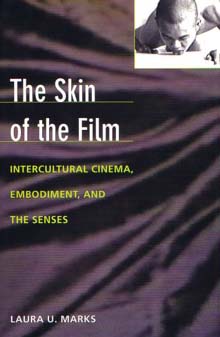
Laura U. Marks, The Skin of the Film, Duke UP, 2000.
If cinema is an audiovisual medium in nature, why does Laura Marks look for nonaudiovisual sense experience in cinema? Of course, the films and videos she tries to examine are not just the general cinemas but what she calls intercultural cinemas. Why does intercultural cinema matter? For her, “many new works in film and video call upon memories of the senses in order to represent the experience of people living in diaspora”(xi). When two or more cultures encounter one another (for many reasons such as exile, emigration, or colonialization), new forms of sense experience and new mode of bodily representation are required. If, in this new way of sense perception, an original cultural value (cultural memory) is visually irrepresentable not possible, cinema tends to use other modes of representation – for instance, silence or absence of visual image. Marks argues that intercultural cinema “expresses the disjunction between orders of knowledge, such as official history and private memory, by juxtaposing different orders of image, or image and sound tracks that do not correspond to each other”(31). Furthermore, sometimes images should be created when there is no image to be represented, for there should be an image in order for memory to be called up.
Intercultural cinema tends to evoke forgotten or disappeared cultural memories through the senses other than audiovisual – such as smell, taste, and touch. As Marks asserts, “one of the important ways that cinema can embody cultural memory is by awakening memories of touch”(22). Absence of visual images to present makes intercultural cinema excavate the concrete objects – what Marks calls transnational objects. These objects, as sort of fetishes and radioactive fossils, “can encode knowledges that become buried in the process of temporal or geographic displacement but are volatile when reactivated by memory”(85). According to Marks, intercultural cinema activates a cultural memory by evoking tactile memory, since the sense of touch can embody memories that are unavailable to vision. Since memory functions multisensorially, intercultural cinema may activate a memory which involves all the senses. Thus, the task of intercultural cinema is to call up the meanings which reside in the objects and to evoke memories stored in the bodies. Cinema can evoke the sense of touch by appealing to “haptic visuality” in which “the eyes themselves function like organs of touch”(162). In this way, haptic images in cinema invite viewers to look at what is on surface of the screen and haptic visuality requires “the viewer to work to constitute the images, to bring it forth from latency”(183).
In Marks’s theory of haptic visuality, what is the exact relation between image, objects, memory, sense, and film? How an event is memorized as images and how can material objects, if not related with the body which embodies the memory, reserve memory (meaning) – which is likely to be believed as immaterial? What is the relationship between the way film deals with images and memory objects and the way viewers (spectators) deal with film as image or memory object? To the process in which cinema records, embodies, and reconstructs images of memory, how can viewers intervene?
Concerning Rancière’s assertion on the close relationship between politics and aesthetics, Marks’ theory of haptic visuality might be a good methodology to examine its effectiveness. Her theory might be useful when we ask how cinema as a medium can make new organization of senses (sensorium) through the experiment of sense, image, and memory, and how that new mode of bodily representation or cultural memory can be political. Her use of Deleuze’s theory of cinematic images – mostly from Cinema books – in this book could be complemented by Deleuze’s other books: especially, Proust and Signs for the discussion of memory and Francis Bacon: The Logic of Sensation for the discussion of the haptic.